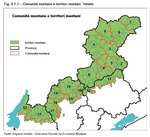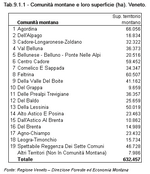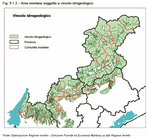When referring to mountains, knowing the geographical background is necessary as the regulations governing them are complex because of the various classifications.
Academics and geographers have long been engrossed in defining mountains. Back in 1933 Raoul Blanchard wrote that "it is almost impossible to give a clear, comprehensive definition of mountains".
From a legal point of view, for mountain area, reference is made to the classification used by the State in accordance with Law 991/52 "Measures in favour of mountain areas" based on a specific order of the Constitution: "The law acts in favour of mountain areas" (Art. 44 Clause 2 of the Constitution). The Italian Constitution, as well as the Spanish and Swiss ones (within a European context), contains an explicit reference to "mountains", which envisages that Parliament may adopt special measures in their favour
(Note 1).
Mountain areas are identified by the Commissione Censuaria provinciale and classified as such by the Commissione Censuaria centrale following deliberation.
Regione Veneto
(Note 2) has set up a procedure for regional classification to complete and integrate the State's classification carried out according to criteria established by Community Directives
(Note 3).
Along with this classification of mountain area is the legislation for Mountain Communities
(Note 4). This legislation established that previously classified mountain areas should be divided according to economic and social criteria in homogenous zones which were to be set up as Mountain Communities.
With this legislation, State intervention was not limited to promoting the primary sector. It also led to valorising mountain areas according to geographical, cultural and economic features, and because of this these areas required specific planning and management.
Veneto currently has 19 Mountain Communities
(Note 5) which cover 171 mountain municipalities (completely or partially) and are distributed across four provinces: Belluno has nine Mountain Communities, Vicenza six, and Treviso and Verona two each.
(Figure 9.1.1) and
(Table 9.1.1).
The European Economic Community (EEC) made a significant classification with its definition of mountain areas with specific handicaps. With Directive 268/75/EEC on farming in mountain and less-favoured areas, criteria were established for defining areas with specific handicaps. Directive 273/75/EEC approved the first list of less-favoured areas.
In this context, mountain areas are considered less favourable for farming because of unfavourable negative elements. In particular, according to Art. 3 of the 1975 Directive, possibilities for the use of land in mountain areas are considerably limited and there is an appreciable increase in labour costs due to the very difficult climatic conditions caused by high altitude and/or steep slopes.
With Regulation 1698/05 on support for rural development by the European Agricultural Fund for Rural Development (EAFRD), mountain areas with specific handicaps took on a new definition of mountain areas.
Another significant classification concerns hydrogeological restrictions, which affect nearly all mountain areas.
Hydrogeological restrictions
(Note 6) aim to protect land for which woodland has a conservational, protective role. In the area in which these hydrogeological restrictions have been established, issues concerning production must take into consideration the safeguarding of the territory's hydrogeological stability, in which woodland has an instrumental role of public interest.
According to Art. 7 of the Royal Decree, for affected land, forestry authorities, who establish how work can be carried out, must provide "authorisation [...] for the transformation of wood into other types of cultivation and the transformation of stable terrain into terrain subject to periodical cultivation"
(Figure 9.1.2).







